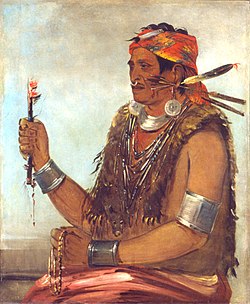Tenskwatawa

Tenskwatawa, född 1775, död 1836, var en religiös och politisk ledare bland shawneerna vilken av sina amerikanska motståndare kallades för the Shawnee Prophet.
Lära
Tenskwatawas lära fördömde det amerikanska folket som djävulens barn genom att anknyta till de religiösa idéer som manifesterades redan i Fort Ancient-kulturen, där Stora Ormen kom från havet och stod för det onda. Tenskwatawa förklarade nämligen att amerikanerna kom från havet och var Stora Ormens avkomma. Hans religion hade karaktär av väckelse, shawneer som hade övergått till kristendomen förföljdes och hans anhängare var förbjudna att använda europeiska födoämnen, europeiska kläder och verktyg samt alkohol.
Tecumsehs krig
Tenskwatawa var bror till Tecumseh, ledare för den politiska och militära konfederation, Tecumsehs konfederation, som skapades med Tenskwatawas väckelse som religiös drivkraft. Genom Tecumsehs krig försökte konfederationen genomföra Tenskwatawas religiösa vision, men den föll sönder när Tecumseh stupade 1813. Genom Tecumseh spred sig Tenskwatawas väckelse till sig ända till creekerna och var en drivande kraft bakom Creekkrigets utbrott 1813.
Referenser
- Den här artikeln är helt eller delvis baserad på material från engelskspråkiga Wikipedia, Tenskwatawa, 26 oktober 2012.
Litteratur
- R. David Edmunds, The Shawnee Prophet (Lincoln : Univ. of Nebraska Press, 1983). Libris (bibliotekskatalog)
|
Media som används på denna webbplats
Ten-sqúat-a-way, The Open Door, Known as The Prophet, Brother of Tecumseh. “The ‘Shawnee Prophet,’ is perhaps one of the most remarkable men, who has flourished on these frontiers for some time past. This man is brother of the famous Tecumseh, and quite equal in his medicines or mysteries, to what his brother was in arms; he was blind in his right eye, and in his right hand he was holding his ‘medicine fire,’ and his ‘sacred string of beads’ in the other. With these mysteries he made his way through most of the North Western tribes, enlisting warriors wherever he went, to assist Tecumseh in effecting his great scheme, of forming a confederacy of all the Indians on the frontier, to drive back the whites and defend the Indians’ rights; which he told them could never in any other way be protected . . . [he] had actually enlisted some eight or ten thousand, who were sworn to follow him home; and in a few days would have been on their way with him, had not a couple of his political enemies from his own tribe... defeated his plans, by pronouncing him an imposter . . . This, no doubt, has been a very shrewd and influential man, but circumstances have destroyed him . . . and he now lives respected, but silent and melancholy in his tribe.” Records show that the Prophet was living west of the Mississippi by 1830, which suggests that Catlin painted this portrait at Fort Leavenworth (in today’s Kansas) on his earliest journey to the West. (Catlin, Letters and Notes, vol. 2, no. 49, 1841, reprint 1973; Truettner, The Natural Man Observed, 1979)
